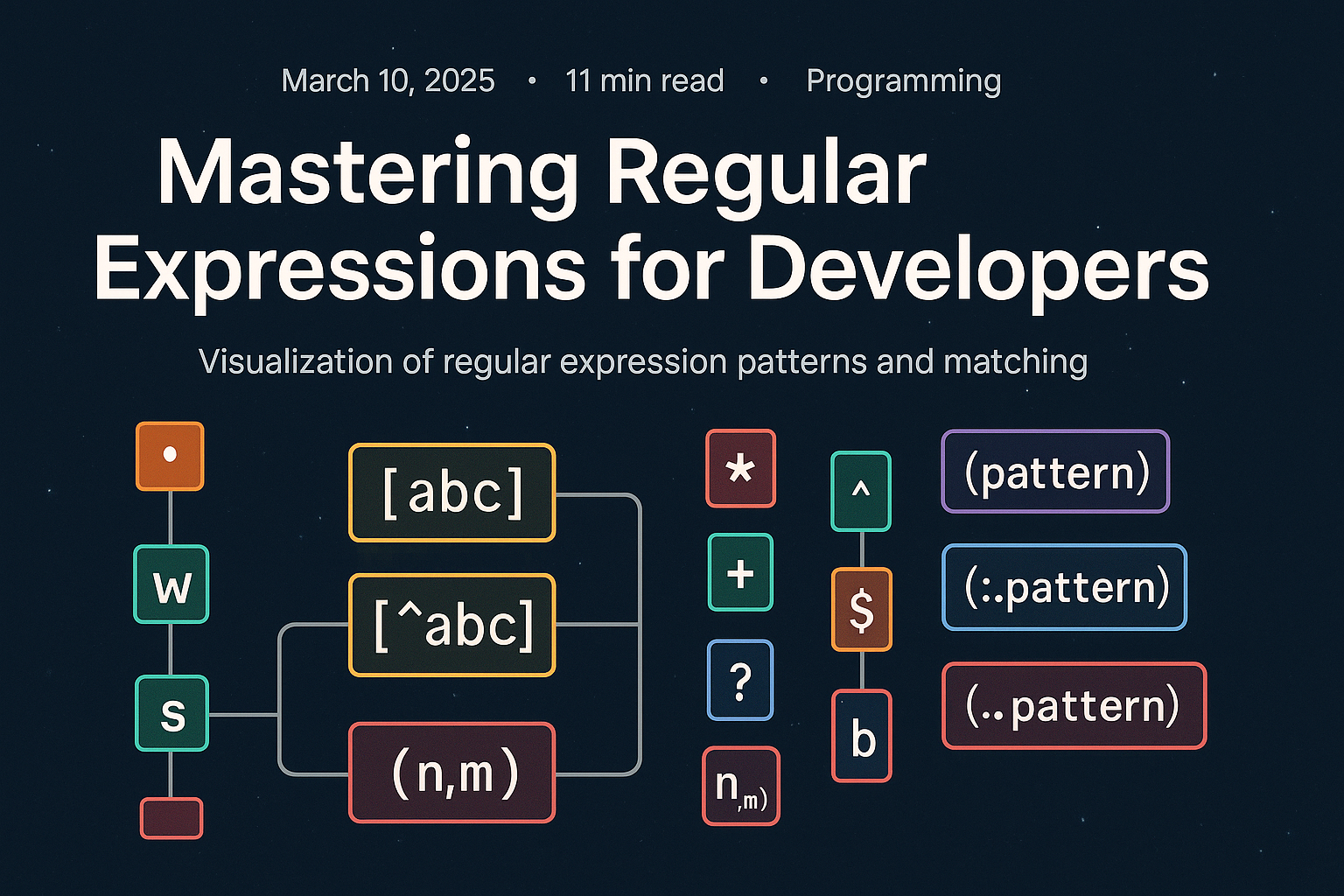Mastering Regular Expressions for Developers
Regular expressions (regex) are powerful tools for pattern matching and text manipulation. Despite their cryptic appearance, they're incredibly useful for developers across all domains. This guide will help you understand and master regex for your everyday coding challenges.
What Are Regular Expressions?
Regular expressions are sequences of characters that define a search pattern. They can be used for string searching, string replacing, input validation, and parsing. Almost every programming language supports regex, making it a universal skill for developers.
Basic Syntax and Patterns
Let's start with the fundamental building blocks of regular expressions:
Character Classes
.- Any character except newline\d- Digit (0-9)\w- Word character (a-z, A-Z, 0-9, _)\s- Whitespace character[abc]- Any of the characters a, b, or c[^abc]- Any character except a, b, or c[a-z]- Any character from a to z
Quantifiers
*- 0 or more occurrences+- 1 or more occurrences?- 0 or 1 occurrence{n}- Exactly n occurrences{n,}- n or more occurrences{n,m}- Between n and m occurrences
Anchors and Boundaries
Anchors and boundaries help you match patterns at specific positions in the text:
^- Start of a string or line$- End of a string or line\b- Word boundary\B- Not a word boundary
Capture Groups and References
Capture groups allow you to extract portions of the matched text and reference them later:
(pattern)- Capture group(?:pattern)- Non-capturing group\1,\2, etc. - Backreferences to capture groups
Example: Using Capture Groups
javascript
// Swapping first and last name
const name = "Smith, John";
const swapped = name.replace(/([^,]+),\s*(.+)/, "$2 $1");
console.log(swapped); // Output: "John Smith"
Lookaheads and Lookbehinds
Lookaheads and lookbehinds (collectively called "lookarounds") are advanced features that allow you to match patterns only if they're followed by or preceded by another pattern, without including the lookaround pattern in the match:
(?=pattern)- Positive lookahead(?!pattern)- Negative lookahead(?<=pattern)- Positive lookbehind(? - Negative lookbehind
Example: Password Validation with Lookaheads
javascript
// Password must contain at least:
// - 8 characters
// - 1 uppercase letter
// - 1 lowercase letter
// - 1 number
// - 1 special characterconst passwordRegex = /^(?=.<em>[a-z])(?=.</em>[A-Z])(?=.<em>\d)(?=.</em>[!@#$%^&*()]).{8,}$/;
console.log(passwordRegex.test("Weak123")); // false (no special char)
console.log(passwordRegex.test("Strong123!")); // true
Common Regex Patterns for Developers
Here are some commonly used regex patterns that you might find useful in your projects:
Email Validation
javascript
const emailRegex = /^[a-zA-Z0-9._%+-]+@[a-zA-Z0-9.-]+\.[a-zA-Z]{2,}$/;
URL Validation
javascript
const urlRegex = /^(https?:\/\/)?([\da-z.-]+)\.([a-z.]{2,6})([/\w .-]<em>)</em>\/?$/;
Date Validation (MM/DD/YYYY)
javascript
const dateRegex = /^(0[1-9]|1[0-2])\/(0[1-9]|[12]\d|3[01])\/(19|20)\d{2}$/;
IP Address Validation
javascript
const ipRegex = /^(?:(?:25[0-5]|2[0-4][0-9]|[01]?[0-9][0-9]?)\.){3}(?:25[0-5]|2[0-4][0-9]|[01]?[0-9][0-9]?)$/;
Regex in JavaScript
JavaScript has built-in support for regular expressions through the RegExp object and string methods:
JavaScript Regex Methods
test()- Tests for a match in a string. Returns true or false.
javascript
const regex = /hello/;
console.log(regex.test("hello world")); // true
exec()- Executes a search for a match in a string. Returns an array of information or null.
javascript
const regex = /hello (\w+)/;
const result = regex.exec("hello world");
console.log(result[1]); // "world"
match()- Returns an array containing all matches, or null if no match is found.
javascript
const str = "The rain in Spain";
const matches = str.match(/ain/g);
console.log(matches); // ["ain", "ain"]
replace()- Returns a new string with some or all matches replaced.
javascript
const str = "Hello world";
const newStr = str.replace(/world/, "JavaScript");
console.log(newStr); // "Hello JavaScript"
Performance Considerations
While regex is powerful, it can also be computationally expensive if not used carefully:
- Catastrophic Backtracking: Certain patterns can cause exponential time complexity
- Greedy vs. Lazy Quantifiers: Use
*?,+?, etc. for lazy matching - Anchors and Boundaries: Use them to limit the search space
- Alternatives: Sometimes simple string methods are more efficient
Testing and Debugging Regex
Regular expressions can be difficult to debug. Here are some tools and techniques to help:
- Online Regex Testers: Sites like regex101.com, regexr.com, and debuggex.com
- Unit Testing: Write tests for your regex patterns
- Commenting: Use the
xflag (when available) for verbose mode with comments - Build Incrementally: Start with simple patterns and gradually add complexity
Conclusion
Regular expressions are a powerful tool in a developer's toolkit. While they may seem intimidating at first, with practice and understanding of the basic principles, you can leverage them to solve complex text processing problems elegantly.
Remember that regex solutions should be balanced with readability and maintainability. Sometimes, a simple string method might be more appropriate than a complex regex pattern. As with any tool, knowing when to use it is as important as knowing how to use it.
Keep practicing, refer to this guide when needed, and soon you'll be writing complex patterns with confidence!



